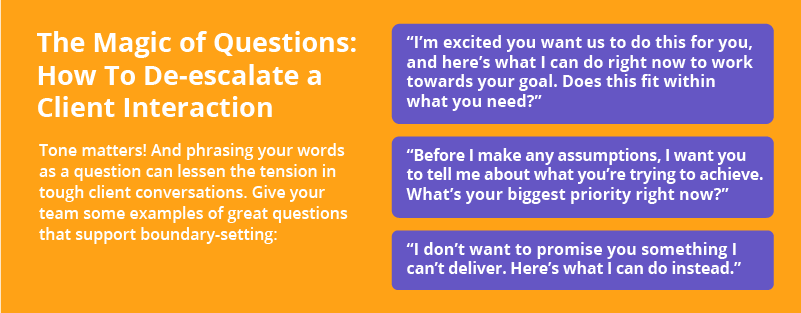Relationships with clients are the lifeblood of any professional services business, but they aren’t perfect or easy by any means. These vital connections can be vulnerable to the same problems as other types of relationships.
One common issue is fearing that you’ll lose the other party in an important relationship. Wanting to please your clients to prevent this loss at all costs can leave your team drained. Instead, it’s helpful to be aware of appropriate professional boundaries and how to communicate them.
Robert Germain, Accelo’s VP of Client Success, is quite practiced at having uncomfortable conversations as a service provider. His team is largely responsible for Accelo having received G2’s Best Relationship badge for Summer 2022.
Here, he shares his best advice for maintaining a strong partnership with clients through the ups and downs you experience together.
What do boundaries look like in a business context?
Robert: “You need to have strong processes in place and strong adherence to those processes. Ideally, these should be established before a problem arises.
Unfortunately, most business owners don’t recognize the need for boundaries until something goes wrong with a client. It often happens early on because every door is open, and all you may care about is getting money in.
While that’s normal, it means you’re probably going to learn the hard way that you’re giving away too much for too little. As companies mature, they tend to see the benefits of having boundaries: controlling costs and increasing capacity.
The same way you need boundaries in your personal life, you need them in business. They’re just a bit more structured.”
How do you recommend training employees to enforce boundaries with clients?
Robert: "You should decide on boundaries in terms of the limits of what you’re willing to do. Then, enable your team to adjust as specific scenarios come up where those limits aren’t quite sufficient.
First, training about boundaries should be focused on communicating the foundation of your processes and expectations to clients who are upset or expressing unreasonable demands. Consistency on policies is key as your client base grows. And making promises without remembering those processes is going to create even bigger problems for everyone.
Then, help your team understand that when things go sideways, it’s important to be friendly, listen to the client’s concerns and then ask if there’s something you can take off their priority list right away. What can you do right now to make them feel they’re being listened to?
When you’ve exhausted those options, boundaries are sometimes better enforced by a manager who has more experience. Some personalities aren’t comfortable making autonomous decisions on the spot yet. It’s a learned skill. Plus, having standards in place for escalating a grievance can help your employees feel supported. The last combination you want is both an unhappy customer and an unhappy employee.”
Let's say I run a management consulting firm. We have a few clients who seem to bring us nothing but problems, despite our efforts to set boundaries. What now?
Robert: "Remember that the customer is not always right, even though that’s something people in service businesses love to say. As the service provider, you deserve to be listened to just as much as the client does. A productive conversation must always be a two-way street.
Your company values and training protocol should represent the fundamentals of great customer service, but that doesn’t mean your team doesn’t also deserve respect.
If a client consistently shows up disrespectfully, you can walk away. That’s not a decision you want to put in the hands of every team member, but if you have a client who’s consistently violating boundaries and it’s starting to take time and effort away from more important things, it might be time to consider it.”
“At any given time, it’s likely that 90% of your clients are doing well and 10% are not feeling the love. Only a small percentage of your clients really needs special attention right now. Give them that when they need it and you’ll have less pressure to manage boundaries all the time.”
- Robert Germain
Do you have any suggestions for the kind of language to use to maintain boundaries in client relationships?
Robert: "It’s not so much about the exact words you use, but the empathy underneath them. Be human, be real, be compassionate.
That might mean saying ‘Let’s talk about it,’ instead of repeating a canned phrase over and over. It might mean reminding the client that they’re important to you. Simple statements that indicate that you value the other person can go a long way.”

In times of economic uncertainty, a lot of business owners have to deliver difficult news to clients. What's your advice for doing so in the most compassionate way?
Robert: “First of all, put yourself in the client’s shoes. Everyone’s facing the same kinds of dilemmas, so acknowledge the shared pain of that.
It’s also critical to tell the truth. Why are you raising your prices? Why are you removing a service from your offerings? Give them some context and they’ll be more likely to respect your reasoning. And be reasonable about time frame. No one likes someone to spring bad news on them and give them a day to respond.
The most important part is to keep your relationship alive by following up. When they see a partnership versus seeing your business as a non-human entity, those difficult things you have to tell them will have a lot less negative impact.”

We know of a way you can reduce the frequency of awkward conversations with clients. Use a platform that supports seamless communication and transparency! Schedule a demo of Accelo to see how the right tech can help you maintain healthy boundaries and enjoy your client interactions even more.

